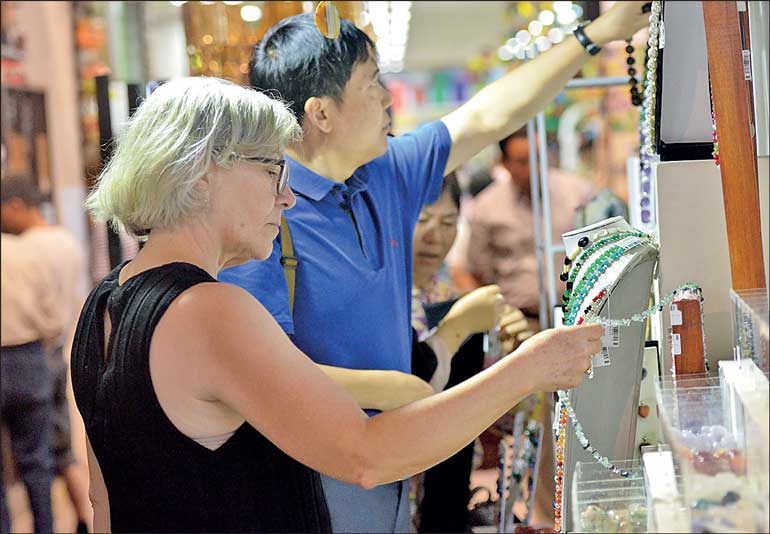Thursday Jan 08, 2026
Thursday Jan 08, 2026
Thursday, 16 December 2021 00:00 - - {{hitsCtrl.values.hits}}

Tourism easily wins the debate of what economic activity will best stimulate the economy; the Government should give every assistance to it to get this industry up and running as quickly as pos-sible – Pic by Shehan Gunasekara
|
 To get the economy motoring and to lift the economic gloom caused by COVID, what is the best proposition? To target getting large investment projects or to target attracting tourists to come next week? There is little room for debate. Clearly tourism is the better proposition for two rea-sons. Large investment projects have a long gestation period and many moons will go by before the first sod is cut to start the project. Then a large part of the investment will go back out of the country for import of plant and machinery. If the contract is given to a foreign contractor, the payments to the contractor and the foreign labour component will also leak out of the country, and so will the profits of the contractors. To see mega projects in the correct perspective all proposals for a major investment project should be compelled to provide the details of money in from the investor and the money that will go out. It will relate an interesting story. Tourism on the other hand where we are using the existing infra-structure will result in 100% of what the tourists spend remaining in the country.
To get the economy motoring and to lift the economic gloom caused by COVID, what is the best proposition? To target getting large investment projects or to target attracting tourists to come next week? There is little room for debate. Clearly tourism is the better proposition for two rea-sons. Large investment projects have a long gestation period and many moons will go by before the first sod is cut to start the project. Then a large part of the investment will go back out of the country for import of plant and machinery. If the contract is given to a foreign contractor, the payments to the contractor and the foreign labour component will also leak out of the country, and so will the profits of the contractors. To see mega projects in the correct perspective all proposals for a major investment project should be compelled to provide the details of money in from the investor and the money that will go out. It will relate an interesting story. Tourism on the other hand where we are using the existing infra-structure will result in 100% of what the tourists spend remaining in the country.
Huge market for tourism
There is a huge market for tourism. Before the current problems Thailand had 46 million tourists, Malaysia 26 million, Cuba and Jamaica both sun and sand destinations 4 million each. Sri Lanka had by then crossed the threshold of two million plus tourists. That’s the potential available to us.
We have everything that Thailand and Malaysia can offer tourists. We already have an infrastruc-ture that can support two to three million tourists .That is the crucial factor with tourism. It can give us a great start quickly. We don’t have to build anything to cater to two to three million tourists. We have the hotel rooms, the roads and transport to get tourists to these hotels. In short we have what we need. The missing piece is the people (tourists) and that has to be our focus.
Tourism vs. Port City to get economy galloping
The potential for tourism is so different from aspirations of generating inflows of investment to the patch of reclaimed mud we call the Port City (with China owning a piece of it). Why they need this piece of land has not been explained. That will be a worry.
With tourism we are targeting an individual who wants to go on holiday. Our task is to turn him/her towards Sri Lanka. We can offer sun and sand and friendly people not a jot inferior to anywhere else. The Port City and the BOI have to persuade a potential investor to select Sri Lanka for a major investment activity in preference to any other country. That’s a tough task as we have nothing special to offer but are lumbered with a host of negatives. Unstable economy, with huge debt, lim-ited foreign balances to service our debt and with an unstable political climate mired with the bad smell of rampant corruption. An offering that will not make us the belle every investor wants.
Port City chorus
The chorus that is paid to sing what is on the sheet given is just flying kites each with a tag saying it will bring in investment (in billions).They know and we know that this is a kite flying exercise as they cannot give a time table for bringing in by specified dates specified sums in inward foreign in-vestment. They are not doing this as it is not possible to put days and sums to dreams.
Travails of the BOI
The BOI (an old friend, having been Chairman twice) is also trying the grand macro approach of lots of highly-educated, highly-paid people rushing around the world selling Sri Lanka as a venue for investment in competition with I guess with over 100 countries doing the same thing.
The BOI is hoping that sometime in the future they will be able to show results of actual invest-ments that are made on the ground. I read that when their new toys were to be taken out of the pram, they had a tantrum and decided to go home. In contrast to this macro approach it is good to recall Lee Kuan Yew’s approach when he started his campaign to bring industry to Singapore.
Let me relate my own personal experience. I was sitting in London as the Regional Director for the Sub-Continent and East Asia for Reckitt, a top 100 company in the UK. The Singapore Development Board wanted an appointment to meet me in London.
I agreed, and on the appointed date a young lady came along and wanted half an hour to make a presentation. It was unusual to walk through the door and ask for half an hour to make a presenta-tion. It was a dreary wintry afternoon and she was good looking and had nice legs so I said yes. She made an amazing presentation with all accurate facts and figures. She knew exactly what we were exporting from the UK to Singapore and demonstrated that by saving on the freight alone we could make a substantial incremental profit if we shift manufacturing to Singapore.
The thought of manufacturing in Singapore instead of shipping from the UK was a thought lingering in my mind but slipped as a priority as we were doing very well with our UK sourced sales in the region. Using her presentation as the base document I made a proposal to the Board of Reckitt that we should set up a manufacturing operation in Singapore. The numbers were so good that it was approved without much debate and we set up manufacturing in Singapore. The Singapore Economic Development Board was using the rifle shot approach at that time.
Tourism lends itself to that kind of approach. We can target countries and within perhaps specific socio economic groups. The results can be quick. Air a good story and a few thousand can be per-suaded to book their flights to Colombo.
Lord Keynes multiplier kicks in with tourism
Many years ago he said the best way to stir up a dying economy is to employ thousands to dig ditches and then to fill them up again.
What was subsequently called Keynes multiplier theory was really a simple concept which some-times eludes political decision makers. If you pay 100 to a group of people and if they spent 90% and saved 10% the 100 will create a demand for goods of 900! That’s the multiplier.
The number of times a given payment will create new demand will depend on what percentage a person spends and what percentage is saved. The lower the percentage saved, the higher the multiplier effect. As students we got rid of the jargon and the math and the equations which said lower the propensity to save higher the multiplier and worked it out.
If you pay 100 and the person saves 10 and spends 90 it creates 90 of income to someone else, and if that person save 10%that is 9 and spent81 it creates 81 of income to someone else and it will go on like that until the initial payment of 100 creates a demand of 900 for goods.
What is attractive with tourism is that it will have a high multiplier. What a tourist pays a hotel will result in a very high percentage going out as wages and payment for what is required for the hotel. Whatever the tourist spends himself whilst in the country on food and drink tuktuks, etc. will all go to creating income with the multiplier effect. In contrast a major billion rupee project will see a large part of what comes in going out. A small percentage of the investment will be paid out to Sri Lankans.
Tourism easily wins the debate of what economic activity will best stimulate the economy. The Government should give every assistance to it to get this industry up and running as quickly as pos-sible.